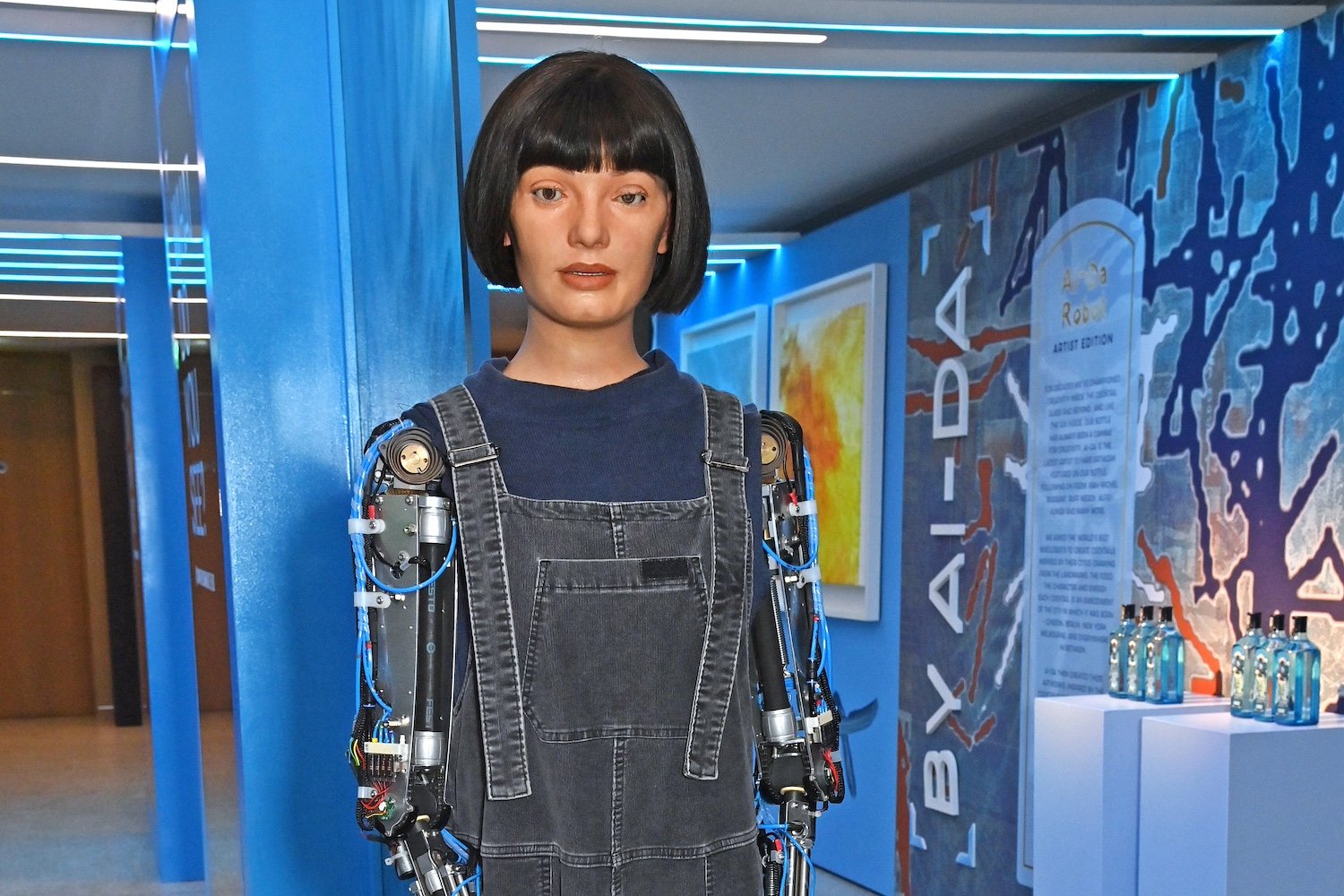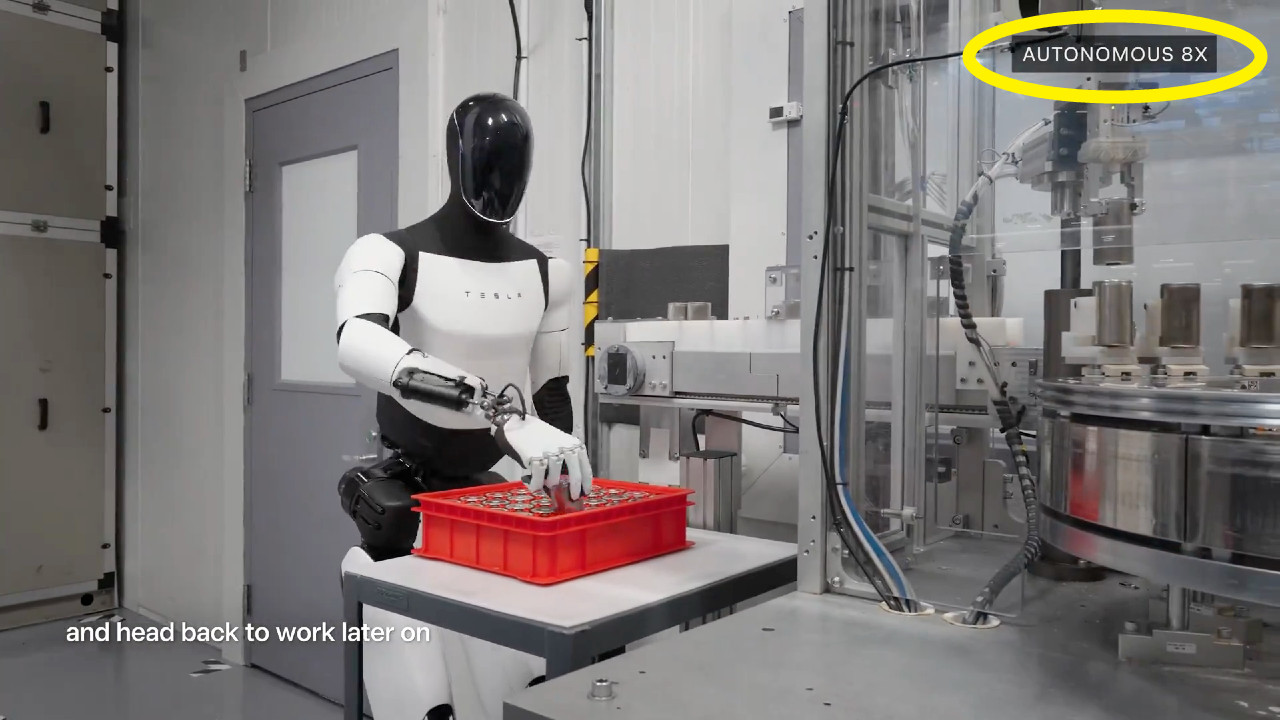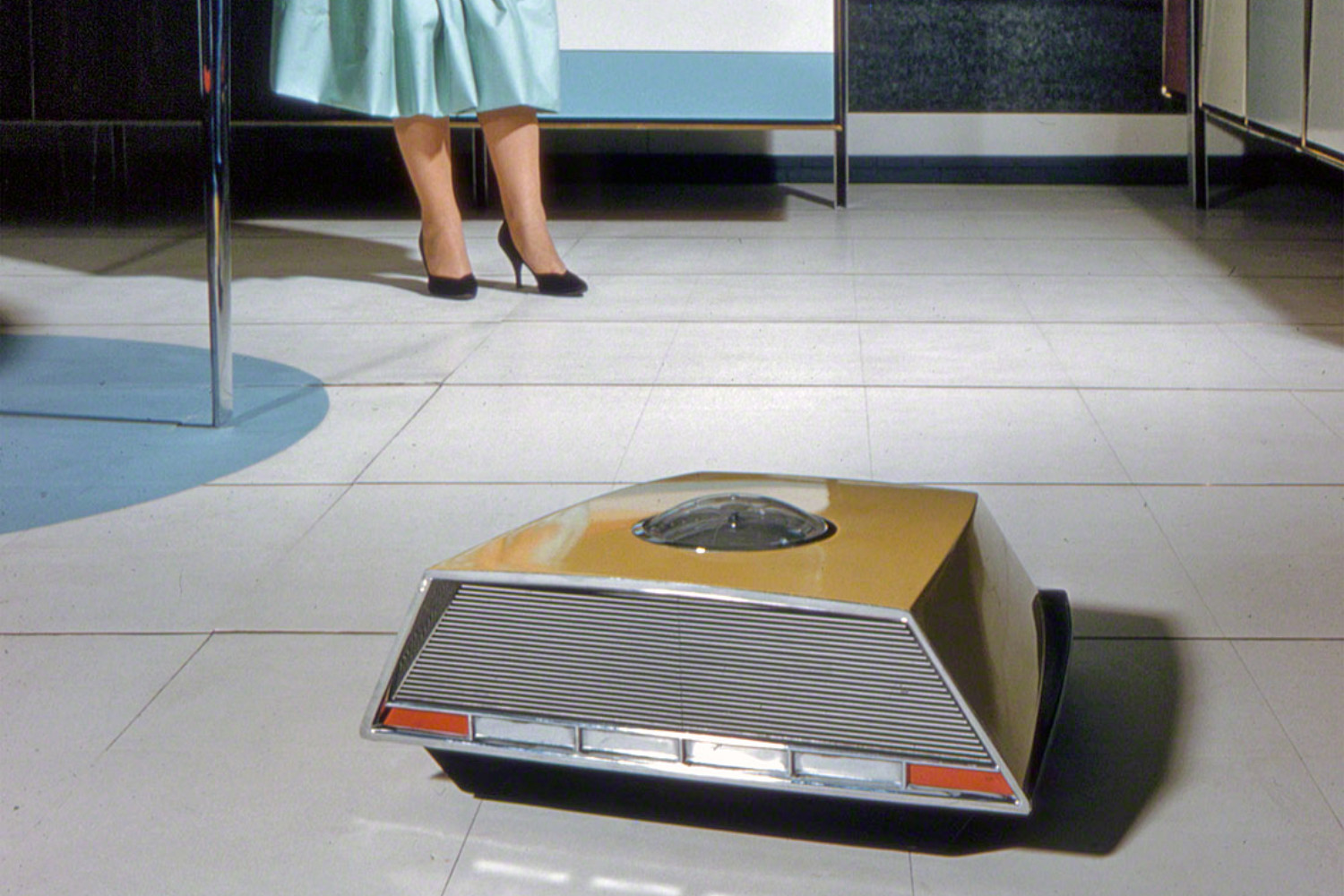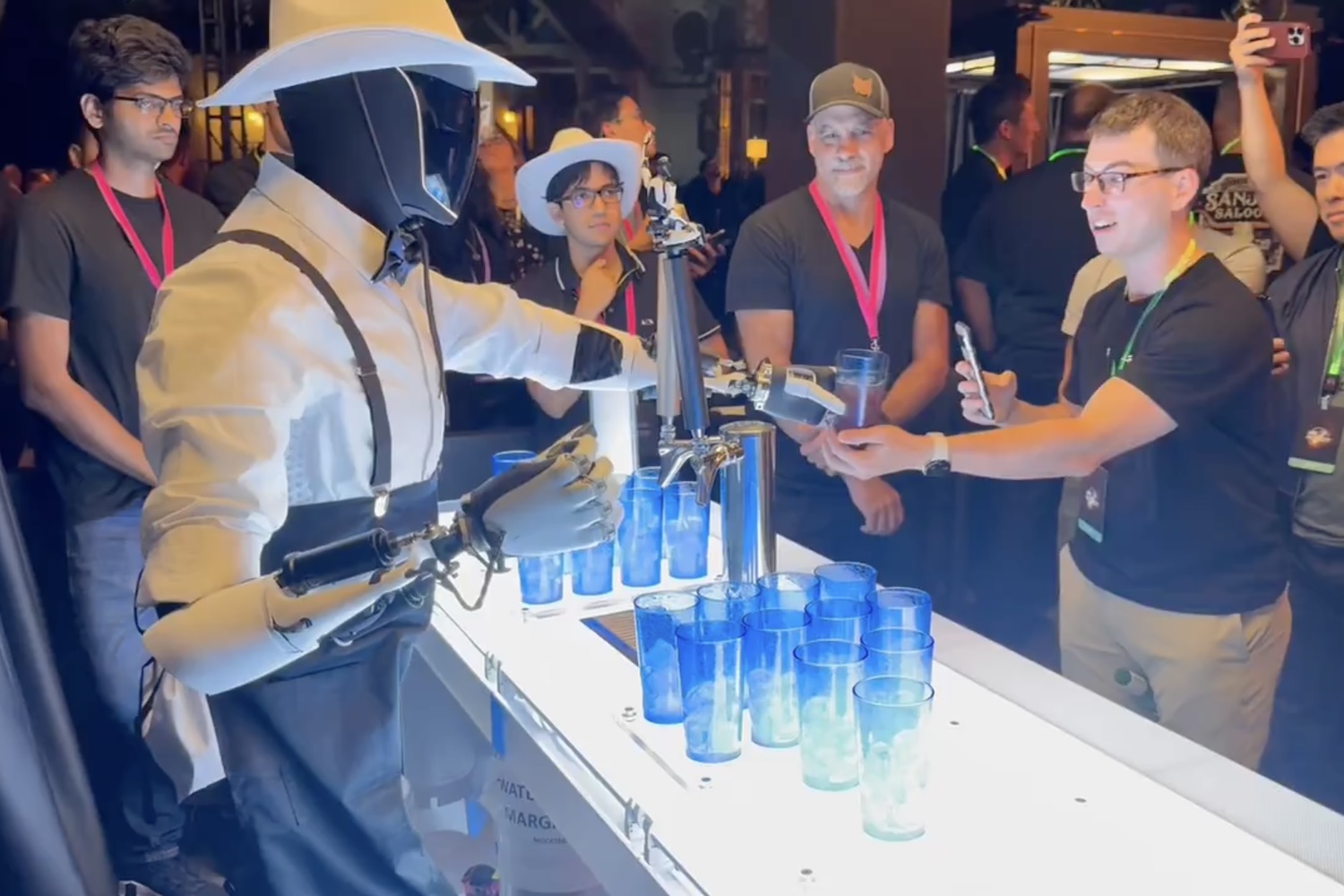It wasn’t the sound that was so shocking. It was the air itself that hit me as I stood mere feet from the polycarbonate resin wall that separated people from the 220-pound remotely controlled battling robots inside the combat arena.
The air hit me with a thump and passed on, attenuating as shock waves do with distance. It jolted me and other nearby observers to attention, spiking our adrenaline in that instant.
A large chunk of metal had sheared off one of the battling robots, and hurtled at an insane velocity to collide with the protective barrier, which instantaneously stretched outward elastically absorbing the force. The polycarbonate bent — bent so far from vertical that it hit the ankle of a woman seated to my left. It bent, but it did not break. Thankfully, while a bright orange heavyweight robot called Polar Vortex was now missing some part of itself (an easily replaced scoop), no humans were irreparably harmed in this instance of combat.
Robots can be dangerous. The larger they are the more dangerous they become as forces grow Newton by Newton and pound by pound (or kilogram by kilogram depending upon your preference). So, as I observe the development of MegaBots — “giant piloted robots and mecha of science fiction” — toward real-world combat readiness, I can’t help but wonder just how dangerous things are going to become.
The MegaBots CEO and co-founder, Gui Cavalcanti says that their “goal as a company, is to start a sports league that has a huge live audience at every single match.”
It’s unclear how they will succeed at their goal while keeping everyone safe.
The rules of robot battle
Years of experience with battling bots has led to the development of standard operating procedures to keep people safe from harm. For example, at this year’s RoboGames where I worked as an on-camera host interviewing contestants about their robots, there were very specific rules regarding who could be inside the combat arena and when. First, the remote control had to be disabled by the driver. Only then could one member of the bot-building team enter the arena to manually turn off the robot with a key. This process was reversed for bots entering the arena to fight.
Human safety is of utmost concern where robots and robot battles are involved, especially with regard to the audience. Certainly, there is an aspect of showmanship to public events like RoboGames and BattleBots. The bot-builders need to put on a good show to keep people entertained. However, there is also a certain amount of risk taken on by everyone in attendance at a robot combat event, since a good show often means lots of flying robot shrapnel as powerful weapons make hit after hit to their opponents.
A single match between heavyweights can leave the arena floor littered with small metal shavings, bolts that have been sheared from their settings, and chunks of solid metal sometimes inches in size. One match involving a robot called Last Rites, which uses a solid metal kinetic spinning weapon, left a gash in one of the arena’s steel structural beams that was at least an inch deep and several inches long. It cut into the steel as if it were butter.
The gash made by Last Rites in the arena’s steel structural beam
These days the amount of risk to the audience is much less than it used to be. According to David Calkins, roboticist and founder of RoboGames, when high profile robot combat effectively got its start with the San Francisco-based show Robot Wars there wasn’t much of a barrier between the robots and the audience.
David Calkins at work in front of the combat arena where the judges sit
Robot-maker Mark Setrakian was quoted in an article as saying that “in those days there was no real protection for the audience, just a little one-foot tall wooden railing around the perimeter.” Robot Wars was picked up for television by the BBC, and season by season the protection for competitors and audience improved.
MegaBots and a whole new fighting category
As Calkins and other robot event planners have learned through the years, if you want a crowd, there need to be safety measures in place to be sure no one gets hurt. Those safety measures then need to be balanced against showmanship. With respect to the new kid on the block, MegaBots, he says, “They are engineers second, and showmen first.”
Image: MegaBots
To succeed, MegaBots needs to approach impending fights as event promoters. Calkins stressed to me that there will have to be some sort of regimen dictating whether it is approached as a spectacle, like Monster Trucks, or a win/lose scenario. If the latter, then how do you determine how a fight develops, and how do you score it? What metrics do you use? Are you looking at the number of paintball hits, or the number of landed punches? He stressed that the RoboGames combat event uses boxing as rules as a guide with scoring based on qualified hits, amount of damage rendered, aggression, and a category fabulously known as the “envelope of destruction.”
According to Calkins, “If you create an envelope of destruction without any aggressive maneuvering, you can gain no points for the damage done to the other robot who is attacking you. So, in other words, if I keep punching your hand with my face, literally, I win even though you break my nose because you’re not actually giving the punches. You’re just holding your arm out in front of me.”
This and the other rules have only come to be out of general consensus. The people developing the sport have to agree that a particular combat construct is acceptable. Who will make the rules for giant piloted robot competition? MegaBots and who else?
Remote-controlled robot fighting has slowly evolved over the years into a well-established system of weight classes and rules. Through “Robot Darwinism”, a term coined by Peter Abrahamson, bots themselves have been winnowed down into a handful of body styles (wedges, spinners, flippers, etc.) that are the most successful in combat.
But, now MegaBots, for the first time ever, are pushing the envelope into new territory, taking the fight out of the hands of drivers with remote controls, and putting drivers into the bots themselves. A whole new fighting category means developing, not only a new system of rules and procedures, and safety guidelines, but also new robot designs.
If you’ve had the luck to see MegaBots in action at places like Maker Faire or San Diego Comic Con, you’ll have noticed that their bot, the Mk II, is currently set up to fire softball-sized three pound paintballs at around 120 mph from massive arm-mounted cannons at targets like cars. The robot stands 15 feet tall, and weighs in at 12,000 pounds (5400 kg).
According to Gui, “The fascinating thing about the MegaBot is that it kind of looks a little small when you are just looking at it though a video screen. But, when you’re standing next to it, and the robot stands next to you and is 15 feet tall to your 5 or 6, all of a sudden you feel like you’re prey… That’s the really exciting thing about seeing the robot in person, is that it is so big, it is so massive that you can’t help feel a little bit small.”
To put this into further perspective Gui said, “Our missile launcher that we’ve just installed on the left arm of the robot weighs 750 lbs. One of our tracks weighs 1700 lbs. All the pieces of our robot weigh more than a human being, and require overhead cranes and construction equipment to move around.
“Me and Matt [Matt Oherlein, MegaBots co-founder] can both comfortably stand on a cannon and work on the upper arm valves, and just sit there with the engine on and just ride the arms of the robot around. We are trivial weight compared to it — Instead of jumping off the robot down to the ground, we can actually climb across the face of it like you would boulder across a rock wall.”
Image: MegaBots
Like Nascar with legs
Size isn’t the only thing that differentiates MegaBots from other combat robots. The Mk II is physically piloted by people, not remotely controlled. It has room for two pilots. Gui likens his vision to Formula One racing.
“For us, F-1 is the most watched sport in the world. It’s like a human being inside a vehicle putting themselves in danger, and performing at the peak of the machine’s performance and the peak of the driver’s performance. And that’s the kind of feeling we want to emulate. Like we are amplifying the human condition, and making people the best that they can be through these giant machines.”
I agree this is a worthy goal, but the driver’s safety needs to be considered within the purview of this fledgling sport. We enjoy watching athletes risk their lives, but we don’t enjoy actually watching them die. How do you protect soft, squishy humans contained inside a giant metal battle-machine?
Luckily, precedent for this exists in engineering used to protect F-1 and Nascar drivers. Not to mention other risky human endeavors like Monster Trucks, the Space Shuttle, and even heavy machinery operation. The list of safety features includes 5-point harnesses, head and neck restraints, air bags, window nets, roll cages, rupture-resistant fuel tanks, lexan windshields, fire-resistant driver suits, among other things.
Initially, the Mk II was designed with a very Western shoot-em up paintball gunfight in mind. The armor and driver’s cage are built accordingly to withstand massive paintball impacts. But, that has to change. In late June, MegaBots challenged a Japanese giant robot maker, Suidobashi Heavy Industries, to a duel. The Suidobashi robot, which is called Kuratas, stands at 12.5 feet, weighs around 9000 pounds (~4500 kg), and is capable of wielding a variety of weapons, responded to the challenge by requesting melee combat.
“Come on guys. Make it cooler. Just building something huge and sticking guns on it… it’s Super American,” said Suidobashi’s founder Kogoro Kurata in his response video.
Gui said that their first reaction was “‘wow, that’s very Japanese.” The fascinating thing is that we both emulated our respective country customs. Like the western approach to giant robots is that they exist to hold giant guns… Then the Japanese approach is very much like we’re putting swords on robots and knives and ridiculous weaponry. …why? why would you do that? Why would you put a giant sword on a robot? It’s supposed to hold a gun.
“So, we thought it was pretty funny that it kind of showed up as this very visceral distinction between Eastern and Western style. Ultimately, we want to fight. So, you know, yea, we’ll throw down melee combat. We want a gun-fight, too. So, that’s what we’re going to push for , but yea, let’s duke it out. Let’s do this.
“It means that we have to really upgrade the armor on our robot because a 3 lbd paintball is very different from a 1500 lb fist. But, we’ll figure it out or we’ll die trying.”
I asked Gui if he was really concerned about dying in combat. He said, “I’m not too terribly worried, but yea, if you’re going to start a new sport, and if you’re going to do something really amazing, you have to take a risk, and that’s what we’re prepared to do. And, besides, Matt’s in front, so I’ll be fine.”
Joking aside, they are currently working to raise funds and create partnerships that will lead to a successful first battle against Kuratas. “Team USA” includes celebrity roboticist Grant Imahara, Greg Munson and Trey Roski from BattleBots, and Peter Diamandis, among others who have been recruited as advisors on the next iteration of the Mk.
A Kickstarter campaign is underway to raise at least $500,000, which will allow them to make the basic upgrades necessary to allow melee combat, and improve their track-based drive system. They have lofty stretch goals to help them go the extra mile in combat” $750,000 will improve weapons systems, $1,000,000 finances a dynamic balancing system, $1,250,000 allows them to work with NASA on “life safety systems”, and $1,500,000 will round the design out with a bitchin’ paint job.
Like Nascar and F-1, this fledgling sport will require sponsorship. Crowdsourcing might give MegaBots the initial boost they need to gain a foothold, but will only take the robot builders so far. Eventually, if Gui and Matt can inspire other builders, grow a big enough audience, and develop a tournament, big money will have to be involved to fund big robot construction. The costs are otherwise prohibitive to the average person at this scale.
The topic of money brings us back to safety. Sponsors won’t be ok with a sport that puts the audience on the line. And, of course, neither are the guys behind MegaBots. While Gui is ok with the prospect of his own death, he is certainly not ok with hurting innocent bystanders.
“For the battles that we’ve been imagining where there’s just paintballs flying around, they top out around the size of softballs, and they kind of fly a little bit faster than the fastest baseball. So, the kinds of foul ball nets that you might see in a baseball game could protect the audience as we envisioned it. Pieces flying off these robots that weigh 50-100 lbs each… that’s something else entirely. It’s what we have to start looking at.”
David Calkins says that there is already precedent for robot combat safety in Nascar. “Do whatever they do,” he said. “You’re dealing with a Nascar car with legs.”
Will MegaBots follow in the footsteps of Nascar? That is yet to be seen. And, I’ll hopefully be watching from a safe place.
Top image: Day Donaldson/Flickr; photos by Dr. Kiki Sanford














